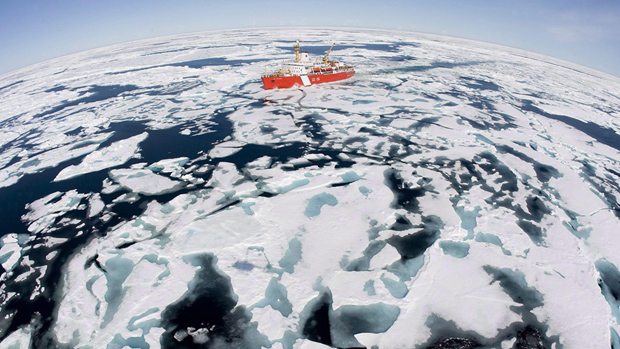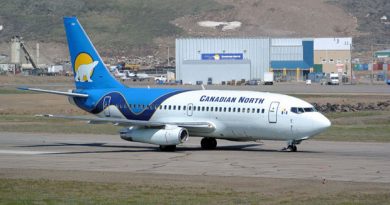Study: Ships may sail over North Pole by 2050
 Imagine a world where ships are able to cross the infamously treacherous Northwest Passage without needing any ice-breaking capabilities, and where some ships can traverse directly over the North Pole. It may be right around the corner.
Imagine a world where ships are able to cross the infamously treacherous Northwest Passage without needing any ice-breaking capabilities, and where some ships can traverse directly over the North Pole. It may be right around the corner.
A study published Monday has found that Arctic sea ice will have dissipated so much by mid-century that both scenarios will be possible during the month of September, opening maritime routes as early as 2040 that could alter the nature of global logistics, and may give Alaska a reason to start developing its Arctic infrastructure.
Satellite mapping has indicated an overall trend of decreasing sea-ice since 1979, study authors Dr. Laurence C. Smith and Scott R. Stephenson of the University of California write in the journal PNAS, and reports of Arctic sea ice hitting its lowest-ever recorded levels in 2012 has fueled discussions on the opening up of Arctic waters to increased traffic.
Some increased traffic has already begun — the Coast Guard recorded 95 ships one day in August between Prudhoe Bay and Wainwright off Alaska’s northern coast — but overall, the discussions of new maritime routes between nations have thus far been “highly speculative,” they write, and this study runs the numbers to see if there is truth to all the talk.
What the study found has major implications for the Arctic. While many issues beyond sea ice levels remain, if the variables do fall into place, companies stand to shave thousands of miles off their maritime voyages. A vessel leaving from Shanghai, China and arriving in Rotterdam, Holland, travels nearly 20,000 miles through the Suez Canal. Taking the Northern Sea Route, which runs along Siberia’s northern coast, would shave nearly 4,000 miles off the journey, and heading directly over the North Pole would save almost 6,000 miles in transit. That translates to a lot saved energy, resources and company time.
By analyzing seven scenarios of sea ice fluctuation for two climate change scenarios – what co-author Stephenson called an “ensemble suite” of existing climate change models — and for two types of vessel classes, they found that by midcentury (2040 – 2059), “unprecedented new optimal navigation routes” through the central Arctic Ocean and Northwest Passage will open up for vessels that are moderately ice-strengthened, and those ships will be able to sail directly across the North Pole. A moderately ice-strengthened ship is one with a strengthened hull and upgraded propulsion system that allows it to enter areas of around one meter of ice, Stephenson said.
Numerous routes will also open up along the Northern Sea Route for regular vessels that have no additional strengthening at all. The study also says that a “dramatic northward shift” may occur, with more navigation heading through the Arctic Ocean instead of along the Northern Sea Route, which today dominates subarctic traffic and commerce for ice-strengthened vessels. That claim may be disputed by Russia, which has poured resources into developing its infrastructure on the Northern Sea Route.
Travel across the Northwest Passage from the eastern U.S. and Canada will be more effective than any other route for ice-strengthened vessels, and will often be the best choice for normal ships, the study finds. However, sailing from Europe to the Northwest Passage will remain unfeasible. And, while the Northwest Passage — infamous for its treacherous waters — may be the shortest route, it is also extremely hazardous, Stephenson noted. For ships heading from New York or farther south, it will still make more sense to sail through the Panama Canal.
Stephenson said that this is the first study to examine Arctic marine transport using a wide range of variables; other studies have used only one climate model, or didn’t take into account different vessel types. Stephenson pointed to consistencies between their work and the broader findings of other studies that have found the Northern Sea Route to be the most technically viable of the Arctic transit routes. But, to their knowledge, this is the first study to look at the viability of the North Pole crossing. He noted that the study findings are only for the month of September, when sea ice levels are at their lowest.
So where does the 49th state fit in? Alaska will need “serious infrastructure upgrades” in order to partake in the increased Arctic traffic, Stephenson said. Alaska does not yet have deepwater ports on the North Slope, which are generally necessary for vessels carrying heavy cargoes. The closest deepwater port is in Dutch Harbor on the Aleutian Islands, more than a thousand nautical miles from Point Barrow at Alaska’s far northern tip.
The need for deepwater ports in Arctic Alaska has not gone unnoticed. “There is a need to invest further in port development for the Alaskan Arctic” the U.S. Army Corps of Engineers and state Department of Transportation said in a draft analysis last month. They have begun drilling on two sites that may serve as a future location of an Arctic deepwater port.
Russia is the only nation so far to make a major push toward investing in increased navigation in the Arctic, Stephenson said; the nation is preparing regulations and tariffs for the Northern Sea Route, and recently moved its Northern Sea Route office to Moscow.
But is heavy traffic in the Arctic by mid-century truly realistic? While navigation across the Arctic will “absolutely” be viable for vessels, whether it will be economical is another matter, Stephenson said. “You definitely have to keep in mind there is both a physical question and an economic question,” and the economic question includes a lot of unknowns.
Vessels that would likely traverse the Arctic would be cargo ships carrying conventional oil, minerals such as zinc and nickel, fishery vessels, and tourists, Smith said, noting that Greenland’s Arctic tourism sector is booming.
The study points to numerous other obstacles besides sea ice standing in the way of increased Arctic navigation, including high insurance fees, a lack of infrastructure and socioeconomic considerations.
“It’s going to depend a lot on the state of global energy markets, which are notoriously difficult to predict,” Stephenson said. The price of oil and locations of natural gas will be big determinants in whether or not Arctic navigation increases.
One scenario where Arctic navigation would increase is if North American shale gas estimates are less bountiful than predicted. That would “reignite interest in Arctic resources,” such as the Shtokman field in Russia’s Barents Sea, Stephenson said.
Environmental and public safety issues are also a major concern. “The Big Kahuna is an oil spill,” Smith said. But interference with mammal migration, and the deposit of soot onto the ice from diesel emissions are also major concerns. Public safety could also be an issue, in such a “remote place with very limited search and rescue ability, and poor nautical charts.”
The study urges the International Maritime Organization to create a regulatory framework “to ensure adequate environmental protections, vessel safety standards, and search-and-rescue capability for this unique and challenging polar ecosystem,” in light of the findings.
Contact Laurel Andrews at laurel(at)alaskadispatch.com
For more stories from Alaska Dispatch, click here



